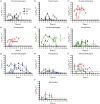Highly pathogenic avian influenza H5N1 clade 2.3.2.1 and clade 2.3.4 viruses do not induce a clade-specific phenotype in mallard ducks
- PMID: 28631606
- PMCID: PMC5825919
- DOI: 10.1099/jgv.0.000806
Highly pathogenic avian influenza H5N1 clade 2.3.2.1 and clade 2.3.4 viruses do not induce a clade-specific phenotype in mallard ducks
Abstract
Among the diverse clades of highly pathogenic avian influenza (HPAI) H5N1 viruses of the goose/Guangdong lineage, only a few have been able to spread across continents: clade 2.2 viruses spread from China to Europe and into Africa in 2005-2006, clade 2.3.2.1 viruses spread from China to Eastern Europe in 2009-2010 and clade 2.3.4.4 viruses of the H5Nx subtype spread from China to Europe and North America in 2014/2015. While the poultry trade and wild-bird migration have been implicated in the spread of HPAI H5N1 viruses, it has been proposed that robust virus-shedding by wild ducks in the absence of overt clinical signs may have contributed to the wider dissemination of the clade 2.2, 2.3.2.1 and 2.3.4.4 viruses. Here we determined the phenotype of two divergent viruses from clade 2.3.2.1, a clade that spread widely, and two divergent viruses from clade 2.3.4, a clade that was constrained to Southeast Asia, in young (ducklings) and adult (juvenile) mallard ducks. We found that the virus-shedding magnitude and duration, transmission pattern and pathogenicity of the viruses in young and adult mallard ducks were largely independent of the virus clade. A clade-specific pattern could only be detected in terms of cumulative virus shedding, which was higher with clade 2.3.2.1 than with clade 2.3.4 viruses in juvenile mallards, but not in ducklings. The ability of clade 2.3.2.1c A/common buzzard/Bulgaria/38 WB/2010-like viruses to spread cross-continentally may, therefore, have been strain-specific or independent of phenotype in wild ducks.
Conflict of interest statement
The authors declare that there are no conflicts of interest.
Figures

References
-
- Centers for Disease Control and Prevention (CDC) Update: isolation of avian influenza A(H5N1) viruses from humans—Hong Kong, 1997–1998. MMWR Morb Mortal Wkly Rep. 1998;46:1245–1247. - PubMed
-
- Cauthen AN, Swayne DE, Schultz-Cherry S, Perdue ML, Suarez DL. Continued circulation in China of highly pathogenic avian influenza viruses encoding the hemagglutinin gene associated with the 1997 H5N1 outbreak in poultry and humans. J Virol. 2000;74:6592–6599. doi: 10.1128/JVI.74.14.6592-6599.2000. - DOI - PMC - PubMed
MeSH terms
Grants and funding
LinkOut - more resources
Full Text Sources
Other Literature Sources
Medical

